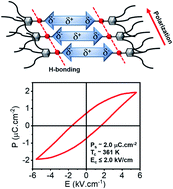Stable room temperature ferroelectricity in hydrogen-bonded supramolecular assemblies of ambipolar π-systems†
Abstract
This article reports H-bonding driven supramolecular polymerization of naphthalimide (A)–thiophene (D)–naphthalimide (A) (ADnA, n = 1–4) conjugated ambipolar π-systems and its remarkable impact on room temperature ferroelectricity. Electrochemical studies confirm the ambipolar nature of these ADnA molecules with the HOMO–LUMO gap varying between 2.05 and 2.29 eV. Electron density mapping from ESP calculations reveals intra-molecular charge separation as typically observed in ambipolar systems. In the aggregated state, AD1A and AD2A exhibit bathochromically shifted absorption bands while AD3A and AD4A show typical H-aggregation with a hypsochromic shift. Polarization vs. electric field (P–E) measurements reveal stable room temperature ferroelectricity for these supramolecular assemblies, most prominent for the AD2A system, with a Curie temperature (Tc) ≈ 361 K and saturation polarization (Ps) of ∼2 μC cm−2 at a rather low coercive field of ∼2 kV cm−1. Control molecules, lacking either the ambipolar chromophore or the amide functionality, do not show any ferroelectricity, vindicating the present molecular and supramolecular design. Computational studies enable structural optimization of the stacked oligomer(s) of AD2A molecules and reveal a significant increase in the macro-dipole moment (in the range of 10–12 Debye) going from the monomer to the oligomer(s), which provides the rationale for the origin of ferroelectricity in these supramolecular polymers.



 Please wait while we load your content...
Please wait while we load your content...